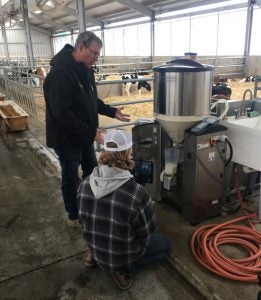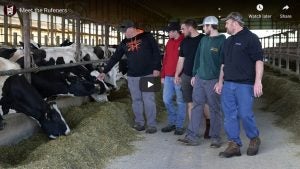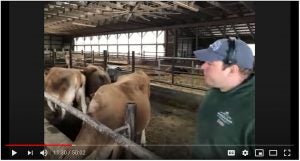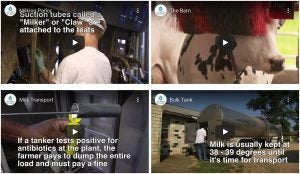You probably agree that it might be a while before visitors come back to farms, and you are thinking this could be the best time to finally create a virtual tour for your website or social media channels. But what should you talk about on a virtual farm tour? What do people want to see?
When building a virtual farm tour, it’s smart to write out what you would like to say so you don’t waste a lot of time editing the videos. I recommend breaking down your virtual tour into stations like you would on a physical tour and then writing out what you would like to say as well as the potential questions you might receive during a live tour.
Stations you should consider setting up for a virtual tour:
- Overall introduction to the farm
- Family values and employees
- Calving area
- Barn / housing
- Cow feed
- Milking parlor
- Maternity / hospital barn
For each station, you will tell a story. You have an amazing story to share as many consumers have never been to a dairy farm and you’ll be their first experience. Which brings us to this question:
Who is your audience?
I recommend that you visualize who your consumer is when writing down your station stories. Think about how you would speak to moms, school kids, or your cousins from the city. This will help direct your language and help avoid complexities of the story you want to tell. For example, with children you want to use simple language, keep it upbeat and focus on the fun aspects of your farm to keep them entertained. For moms, focus on the sophistication of your animal care and environmental practices that protect your animals and your land.

Also consider your role for your audience. You are going to be their tour guide, but you are also their exposure to good dairy farm practices. You are their mentor and teacher, and they are your prized students because if they understand you and like what you are doing, they will share your information with others.
This may seem overwhelming, but you don’t need to write a book for each station. One page of text should create 2 to 4 minutes of video.
In fact, I would recommend that you only write one to two stories for each station. You’ll want to make the tour clear and easy to understand to ensure your story will be remembered.
Which stories / stations should you write out?
1. The Overall Introduction
While people may think it’s easy to introduce yourself, it might be harder when the camera is rolling, so write an introduction of yourself and practice reading it. If you stick to the basics of what people want to know, then you should be OK.
The basics:
What’s your name?
What’s your farm’s name?
Where is your farm?
What kind of farm is it?
How long have you been a dairy farmer?
How long has your farm been around?
How many cows are on the farm?
Why did you become a farmer?
Answer some questions that you normally get from a live tour.
Where are we going next on the virtual farm tour?
Here’s an example.
“Our farm is more than a family business. It’s also about your family. We know that you care about how our cows are taken care of and how careful we are producing the food your family eats. We do all we can to make sure you are comfortable with how we care for our cows. We treat them all with care and respect, and keep them healthy and comfortable, so that they produce one of nature’s best foods — milk.”

2. Family Values and Employees
Showcase your strong farmer / family values. Show how you also care for your employees and their families and how your farm provides a livelihood for them, too.
The basics:
Why do you farm?
How does the farm run?
How do you care for your employees?
What values do you share and act upon?
It’s important to emphasize how the farm has changed from the past. Think about how you will mention modern technology and how it benefits your dairy as well as your thoughts on environmental stewardship and sustainability. People want to know how you care for all aspects of your business — they know you need to make a profit, but they don’t want that to happen at the expense of future generations.

3. Calving Area
People love calves, and it’s always an engaging part of the tour. Keep the focus on the calves and your engagement with them. Remember to emphasize that everything you do is to benefit the animals and their care. Here are some questions you can answer about calves.
The basics:
How old are the calves?
Where are the mothers? (if you have separate housing)
Why are calves in that type of housing?
How long do they stay in the housing?
What does a calf eat and how often?
What happens to male calves on a dairy farm?

4. Barn and Housing
Many people have an image that barns have red, sloped roofs. They may not understand what a modern barn looks like and all of the benefits this type of housing provides for your cows.
The basics:
What type of housing do you provide for your cows and why?
What happens during a normal day for a cow?
What do your cows sleep on?
How often do they sleep?
How can you tell a cow is content?
What are the different sections of your barn?
Are there technologies you use that help maintain the health of the cows?
How do you keep your cows cool?
5. Cow Feed
Many urban consumers are told myths about what dairy cows eat. This is your chance to show them the healthy elements of your cows’ diet and why you’ve selected this type of feed.
The basics:
What do cows eat?
How often do they eat?
What do cows drink and how much? (It’s always good to make comparisons to something consumers can relate to, such as a cow drinks up to a bathtub of water a day.)
What’s an animal nutritionist and how often do you talk to one?
Where does the feed come from?
6. Milking Parlor
The milking parlor is where the magic happens. Milking parlors come in all shapes and sizes so you should explain how your parlor functions to milk your cows. There are lots of moving parts within the parlor, so break down how the system works, from the cows entering the parlor to the milk flowing into the bulk tank and ultimately the tanker truck.
The basics:
How does your milking parlor work? Touch on each step of the milking process.
Do the cows like to be milked?
How much milk does each cow give?
How many times a day do the cows visit the milking parlor?
Where does your milk go?
Are there antibiotics in the milk?
How do you test the milk?
7. Maternity / Hospital Barn
Basically, you are showcasing animal care at its finest as you explain how you care for cows that are in the process of giving birth or those that aren’t feeling well. Show how you take special care of both needs.
The basics:
How often does a cow give birth?
How long are cows pregnant?
How do you help cows that have issues?
How long are cows in the maternity pens?
How do you treat sick cows?
Are sick cows still milked?
What happens to the milk?
What happens to cows after they get better?
Who is your veterinarian?
How long does it take for a calf to stand up on their own?
How much does a calf usually weigh?
Next Steps
After you finish your station stories, read them out loud to yourself or to a friend so you can correct any mistakes and understand the timing. The more you read it, the more comfortable you will be with it and you’ll find your rhythm. This will help when you get in front of the camera. If you are shy about being on camera, you can keep more of the focus on your farm and the animals. You can mainly provide an opening introduction shot so viewers know who is talking and then just film each station. The more you practice, the better you’ll get on camera.
I hope this helps you understand what consumers want to know so you can include it in your virtual tour.
If you are ready to do a virtual farm tour and would like some help, please reach out to your local checkoff through usdairy.com (they have a lot of experience in virtual and physical farm tours) or myself at don.schindler@dairy.org. If you would like to learn more about your national dairy checkoff, you can join our Facebook group or visit usdairy.com.


